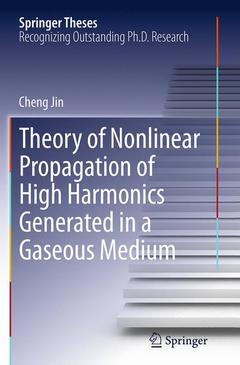Theory of Nonlinear Propagation of High Harmonics Generated in a Gaseous Medium, 2013 Springer Theses Series
Auteur : Jin Cheng

Theory of Nonlinear Propagation of High Harmonics Generated in a Gaseous Medium establishes the theoretical tools to study High-Order Harmonic Generation (HHG) by intense ultrafast infrared lasers in atoms and molecules. The macroscopic propagation of both laser and high-harmonic fields is taken into account by solving Maxwell's wave equations, while the single-atom or single-molecule response is treated with a quantitative rescattering theory by solving the time-dependent Schrödinger equation.
This book demonstrates for the first time that observed experimental HHG spectra of atoms and molecules can be accurately reproduced theoretically when precise experimental conditions are known. The macroscopic HHG can be expressed as a product of a macroscopic wave packet and a photorecombination cross section, where the former depends on laser and experimental conditions while the latter is the property of target atoms or molecules. The factorization makes it possible to retrieve microscopically atomic or molecular structure information from the measured macroscopic HHG spectra.
This book also investigates other important issues about HHG, such as contributions from multiple molecular orbitals, the minimum in the HHG spectrum, the spatial mode of laser beams, and the generation of an isolated attosecond pulse. Additionally, this book presents the photoelectron angular distribution of aligned molecules ionized by the HHG light.
Introduction to High-Order Harmonic Generation.- Theoretical Tools.- Medium Propagation Effects in High-Order Harmonic Generation of Ar.- Comparison of High-Order Harmonic Generation of Ar Using a Truncated Bessel or a Gaussian Beam.- Generation of an Isolated Attosecond Pulse in the Far Field by Spatial Filtering with an Intense Few-Cycle Mid-Infrared Laser.- Effects of Macroscopic Propagation and Multiple Molecular Orbitals on the High-Order Harmonic Generation of Aligned N2 and CO2 Molecules.- Photoelectron Angular Distributions in Single-Photon Ionization of Aligned N2 and CO2 Molecules Using XUV Light.- Summary.
Date de parution : 08-2016
Ouvrage de 159 p.
15.5x23.5 cm
Date de parution : 09-2013
Ouvrage de 159 p.
15.5x23.5 cm
Disponible chez l'éditeur (délai d'approvisionnement : 15 jours).
Prix indicatif 105,49 €
Ajouter au panierMots-clés :
Attosecond Pulse Train; Attosecond Pulses; Cooper Minimum; Experimental HHG Spectra; Gaussian Beam; Harmonic Generation; High Harmonics; High-order Harmonic Generation; Infrared Laser; Isolated Attosecond Pulse; Macroscopic HHG; Macroscopic HHG Spectra; Macroscopic Propagation; Macroscopic Response; Macroscopic Wave Packet; Mid-Infrared Laser; Multiple Molecular Orbiting; Phase Matching; Phase Mismatch; Photoelectron Angular Distribution; Photorecombination Cross Section; Propagation Effects; QRS Theory; Quantitative Rescattering Theory; Shape Resonance; Single-Atom Response; Single-photon Ionization; Spatial Filtering; Strong-Field Approximation; Truncated Bessel Beam; Ultrafast Laser; Wavelength Scaling



